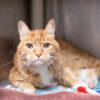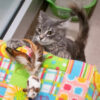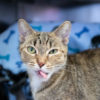Does your cat lie in wait for you to open any door to the outside world? Perhaps your cat is quite obvious about this, always lounging at this door, making a break for it as soon as you open the door? Or, is your cat the kind who hides somewhere nearby, running at full speed from his hiding spot once the door is open? Does your cat run for freedom as soon as you open the door, arms full of groceries, unable to stop him? Why does your cat do this and what can you do to help diminish the behavior?
There’s one thing about our cats that will always be true… they are, at their core, a predator species. Even your well fed, exclusively indoor cat may, once in a while, feel that genetic urge to explore, hunt and return to the pride with their prize. Their need to engage in behaviors that they may not find indoors can also fuel this urge for a taste of the outdoors. Basking in sunlight, scratching on tree bark, climbing to great heights… these are all things that indoor cats often lack, even if we think we’re offering those opportunities. It’s also important to remember that cats rarely capture their prey, but they hunt repeatedly throughout the day, simply because the desire to hunt is so strong and the process is rewarding enough that it doesn’t matter that they’re not successful every time.
So, if it’s in their nature to explore the outdoors, what can you do to dissuade your cat from running out the door every time it opens?
We can start by making sure that the indoor environment is as exciting and rewarding as possible. Offering cat trees in front of windows, even putting up bird feeders outside of those windows, if possible, can give your cat a vantage point to survey what’s happening outside and give them something to focus on other than dashing out the front door to experience it in real life. If your cat loves to rush out the door and roll around in some sunshine, make sure that they have a great window for your cat to bask under, one that receives a full dose of sunshine as often as possible. You can offer a soft, fluffy bed in that spot, too, just to make it even more special. If our cat likes to be up high, offering as many vertical surfaces as possible can be really exciting for your cat. Making sure that you have plenty of cat scratchers that your cat actually enjoys and uses in the home is very important. You’ll also want to make sure that your cat has plenty of engaging, exciting opportunities to hunt, chase and explore in the home, as well. Having toys throughout the home doesn’t do your cat much good if they don’t engage with them. Please see our handout, “Cat Toys and How to Use Them,” for more ideas on playtime with your cat. What’s most important is that your cat is able to engage in true hunt/ catch/ kill behavior with their toys. If the toys aren’t moving, this isn’t possible, so it does require some consistent playtime with their people.
How can I train my cat beyond just playing with them?
This part requires some consistency, but when paired with good environmental enrichment, can be a winning combination. The best place to start is to stop greeting your cat near the door that they’re trying to dash out. No hello’s or goodbye’s at that door, you’re going to move that action to another place in the home. Does your cat have a favorite bed or cat tree? Do all of your greetings there, and in the beginning of training, you’ll want to add in some really great food motivators so that your cat will learn that hello and goodbye happen in the spot, and that there are great treats here, as well, during those moments. Haven’t established this type of space with your cat yet? Now is a great time to do it!!! Remember, food is the best way to gain consistency with the behavior. The more tasty the treat, the more likely your cat will be to understand that they get love and great food in this spot and don’t need to hang out at the door anymore. Even better, invest in some feeding puzzles for your cat and use this space to offer a feeding puzzle that will not only keep your cat occupied but will add another layer to the enrichment that you’re already offering your cat.
Once you’ve moved your greeting area, you can add a sort of failsafe to the process. Keep some treats near the door, as well, which you can toss behind you as you exit the door. If you see your cat attempt to approach he door as you move to open it, toss some treats away from the door, to distract your cat and give you a chance to exit the home. Hopefully we’ve made another space in the home much more interesting and rewarding, but when you’re early in the process, some redirection with treats in this manner may be needed.
You can also add one more layer to this process, if needed. Putting something near the door that your cat doesn’t like can help when your cat is really quite determined. Some cats don’t like walking on aluminum foil and putting a layer of this right outside of the door can help. Similarly, plastic rugs that have nubby plastic backs can be uncomfortable for cats to walk on and can keep a cat from hanging out near the door, if all else fails. Finding a surface that your cat doesn’t like walking on can be helpful in the short term, while you’re working on enrichment and training.
Hopefully, with some enrichment and training, you will see your cat’s desire to rush out the door diminish with time!!







